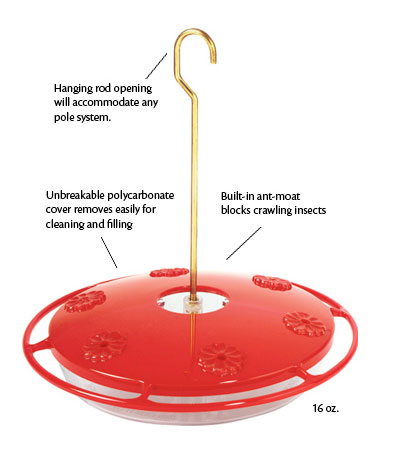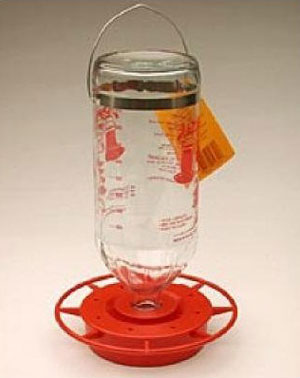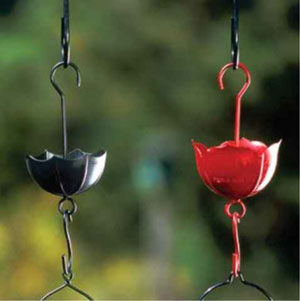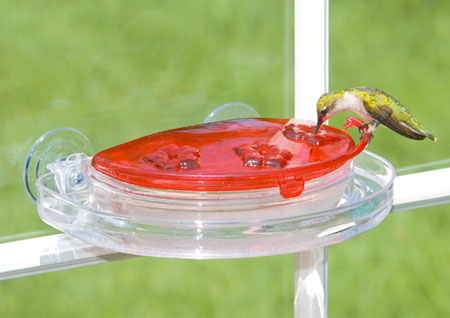
There are a variety of feeders on the market. They range from a simple, single feeding tube to larger feeders with multiple feeding stations. Some people elect to locate several smaller feeders throughout the yard. This approach sometimes helps attract hummingbirds and can reduce the stress of competitive behavior.
Hummingbird Feeder designs and key features
The most popular hummingbird feeders come in one of two designs, saucer-shaped and bottle-shaped.

Bottle-type feeders come with bases of various styles. Before purchasing, make sure the unit you are considering is easy to clean.
In general, you will to select a feeder that has the following features:
- Easy to fill
- Easy to clean
- Insect guard
- Ant moat
Quality hummingbird feeders usually have the above features built into the design. We recommend sticking with products from companies like Aspects or Droll Yankees. Hummingbird feeders are not expensive and a quality feeder will do an excellent job in preventing problems from occurring.
Be wary and do your homework before purchasing hummingbird feeders from grocery or discount stores. Some look really nice, but the designs can make them hard to fill, some leak, and some provide an open invitation to bees and wasps.
Insects
If you feed hummingbirds you will eventually have to deal with insects. Ants can usually be foiled with water barriers or the use of petroleum jelly on the “hard” approaches to the feeder. Flying insects such as bees and wasps can be more difficult. Bee guards are available for many feeder brands and some have bee guards built-in. Spreading petroleum jelly or mineral oil on the surface of the feeder can also be effective in controlling the airborne intruders.

Ant moats can be purchased and placed above a hanging feeder. The moats are filled with water, which prevents ants from crawling down to the feeder. Two colors shown.
Window-mounted hummingbird feeders
Some hummingbird feeders are designed to be attached to a window. It may take a little time for the hummingbirds to become comfortable with feeders so close to the home. Having a feeder nearby will help attract hummingbirds to the area.

Aspects window-mounted feeder.
Fancy hummingbird feeders
There are many fancy looking hummingbird feeders, some of which double as a feeder and a work of garden art. When purchasing one of the fancy feeders, consider the key points listed above. You might be quite willing to spend a little extra time cleaning and filling a feeder, just be sure to understand your options.
When to feed
Put up your feeders as the hummingbirds start to arrive in the spring. Peak southward hummingbird migration occurs in many parts of the country in mid to late September and early October. Feeders should be left up until well after fall migration. As the birds move south, feeders can be a welcome source of energy.
There is also very little evidence that feeders will entice the birds to stay into winter. The migration instinct is strong and almost all healthy birds will head south at the right time. Late fall and winter birds found at feeders are usually juvenile or “confused” birds that have strayed from their normal migratory path. Removing your feeder will do little to reactivate their migration efforts.
Keep reading: When to put out hummingbird feeders?
Feeder locations
Feeders can be located almost anywhere. To help prevent window collisions, some people prefer to place feeders less than two feet from a window, or more than 20 feet.
When first introducing a feeder, it can be advantageous to place the feeder near flowering plants. After the hummingbirds begin to use the feeder, it can be moved to a more convenient viewing location.
Feeder care
Clean your feeder regularly to prevent build up of mold and mildew. Many designs can be placed in a dishwasher.
Make sure to replace any unused feeding solution every 3-5 days. Consider partially filling the feeder at first until you learn how much the birds will consume in the 3-5 day time frame. In hot, summer climates the sugar water can begin to ferment in a day, so adjust the amount you feed based on the temperature.
Keep reading – best hummingbird feeders

